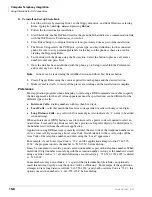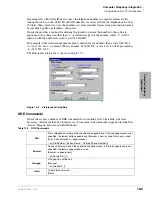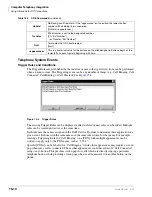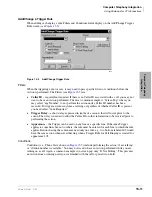
ISDN Interfaces
RPTU Interface Unit
Strata DK I&M 6/00
16-5
ISDN
Inte
rface
s
RPTU Interface Unit
System:
DK40i, DK424 or DK424i Release 4.3
Circuits per PCB:
24 channels
Interfaces with:
ISDN PRI
Older Version(s):
none
The DK40i, DK424 or DK424i Release 4.3 systems supports the RPTU according to the common
control units resident in the system.
The RPTU requires installation of a customer-provided CSU in most locations of the U.S. Refer to
“CSU Requirements” on Page 16-5
for CSU installation.
Testing procedures (local and remote loop back) are in
“RPTU Loop-back Test” on Page 16-38
The RPTU’s LEDs indicate a continuous status of its operation. They are shown in
.
lists the functions for each LED.
Switches, jumpers, and interface connectors are described in
.
RPTU Overview
The RPTU is a DS-1 divided into 24 TDM channels using standard T1 electrical signal format.
The RPTU’s D-channel is typically the 24th channel and can control the signaling of 23 of its own
B-channels and 24 B-channels of another designated RPTU. Each RPTU can also use its own
D-channel for control.
The DK424 or DK424i, RCTUA provides 8 or 16 channels and DK40i provides 8 or 12 channels.
The 24th channel is still available for D-channel control for both systems.
The RPTU’s in-service bit rate is 1.544 mbps (± 4.6 ppm), but during a maintenance session, the
rate may vary ± 32 ppm. The RPTU provides Binary 8-Zero Substitution (B8ZS) and ESF with
Framing Pattern Sequence (FPS) and Cyclical Redundancy Check (CRC) error checking in the
framing bits.
Note
The Embedded Operations Channel (EOC) which carries alarm notifications, statistics,
and error indications is
not
available with DK Release 4.0 software.
Extracting the Stratum-1 clock from the ISDN PRI, BRI, or T1 provider is the most common
method used to synchronize the RPTU PCB and the DK time switch to the public telephone
network. One RPTU, RBSU, RBUU, or RDTU T1 must extract the clock from the ISDN or T1
provider. The selected unit is designated as the “Primary” timing source in system Program *41-1.
In remote cabinet applications, the Primary clock source PCB must be installed in the Base
Cabinet (main location). For more information, refer to
“Timing and Synchronization” on Page
A dealer-supplied CSU must be installed between the ISDN PRI network line and the RPTU PCB
as shown in
. Some telephone companies supply the CSU and call it the Network
Interface Unit (NIU).
CSU Requirements
In the U.S., the CSU must be UL listed and comply with Part 68 of the FCC rules. It must also
comply with the limits for a Class A digital device, pursuant to Part 15 of FCC Rules. In Canada,
the CSU must be CSA certified.
Summary of Contents for Strata AirLink DK40i
Page 22: ...Introduction Related Documents Media xx Strata DK I M 6 00 ...
Page 48: ...DK14 Installation DK14 Wiring Diagrams 1 26 Strata DK I M 6 00 ...
Page 220: ...DK424 Installation Remote Cabinet Installation Instructions 5 68 Strata DK I M 6 00 ...
Page 262: ...DK424i Configuration Primary Reserve Power Cabinet Hardware 6 42 Strata DK I M 6 00 ...
Page 450: ...Universal Slot PCB Wiring Option Interface PCB Wiring Diagrams 10 42 Strata DK I M 6 00 ...
Page 592: ...Peripheral Installation Enhanced 911 Service E911 12 84 Strata DK I M 6 00 ...
Page 616: ...ACD Installation Spectrum Electronic Wall Boards 13 24 Strata DK I M 6 00 ...
Page 634: ...Fault Finding Fault Isolation Flowcharts 14 18 Strata DK I M 6 00 ...
Page 704: ...ISDN Interfaces ISDN Disconnect Cause Code 16 54 Strata DK I M 6 00 ...
















































